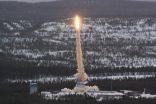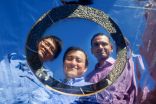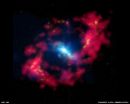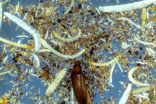INFORMATION:
This research was supported by the National Science Foundation, the National Institute of Child Health and Human Development and the Rothberg Brain Imaging Award.
The Machine Learning Department is part of Carnegie Mellon's top-ranked School of Computer Science, which is celebrating its 25th year. Follow the school on Twitter @SCSatCMU.
About Carnegie Mellon University
Carnegie Mellon is a private, internationally ranked research university with programs in areas ranging from science, technology and business, to public policy, the humanities and the arts. More than 12,000 students in the university's seven schools and colleges benefit from a small student-to-faculty ratio and an education characterized by its focus on creating and implementing solutions for real problems, interdisciplinary collaboration and innovation. A global university, Carnegie Mellon has campuses in Pittsburgh, Pa., California's Silicon Valley and Qatar, and programs in Africa, Asia, Australia, Europe and Mexico.
Carnegie Mellon researchers identify brain regions that encode words, grammar, story
Brain scans of Harry Potter readers yields computational model of reading
2014-11-26
(Press-News.org) Some people say that reading "Harry Potter and the Sorcerer's Stone" taught them the importance of friends, or that easy decisions are seldom right. Carnegie Mellon University scientists used a chapter of that book to learn a different lesson: identifying what different regions of the brain are doing when people read.
Researchers from CMU's Machine Learning Department performed functional magnetic resonance imaging (fMRI) scans of eight people as they read a chapter of that Potter book. They then analyzed the scans, cubic millimeter by cubic millimeter, for every four-word segment of that chapter. The result was the first integrated computational model of reading, identifying which parts of the brain are responsible for such subprocesses as parsing sentences, determining the meaning of words and understanding relationships between characters.
As Leila Wehbe, a Ph.D. student in the Machine Learning Department, and Tom Mitchell, the department head, report today in the online journal PLOS ONE, the model was able to predict fMRI activity for novel text passages with sufficient accuracy to tell which of two different passages a person was reading with 74 percent accuracy.
"At first, we were skeptical of whether this would work at all," Mitchell said, noting that analyzing multiple subprocesses of the brain at the same time is unprecedented in cognitive neuroscience. "But it turned out amazingly well and now we have these wonderful brain maps that describe where in the brain you're thinking about a wide variety of things."
Wehbe and Mitchell said the model is still inexact, but might someday be useful in studying and diagnosing reading disorders, such as dyslexia, or to track the recovery of patients whose speech was impacted by a stroke. It also might be used by educators to identify what might be giving a student trouble when learning a foreign language.
"If I'm having trouble learning a new language, I may have a hard time figuring out exactly what I don't get," Mitchell said. "When I can't understand a sentence, I can't articulate what it is I don't understand. But a brain scan might show that the region of my brain responsible for grammar isn't activating properly, or perhaps instead I'm not understanding the individual words."
Researchers at Carnegie Mellon and elsewhere have used fMRI scans to identify activation patterns associated with particular words or phrases or even emotions. But these have always been tightly controlled experiments, with only one variable analyzed at a time. The experiments were unnatural, usually involving only single words or phrases, but the slow pace of fMRI -- one scan every two seconds -- made other approaches seem unfeasible.
Wehbe nevertheless was convinced that multiple cognitive subprocesses could be studied simultaneously while people read a compelling story in a near-normal manner. She believed that using a real text passage as an experimental stimulus would provide a rich sample of the different word properties, which could help to reveal which brain regions are associated with these different properties.
"No one falls asleep in the scanner during Leila's experiments," Mitchell said.
They devised a technique in which people see one word of a passage every half second -- or four words for every two-second fMRI scan. For each word, they identified 195 detailed features -- everything from the number of letters in the word to its part of speech. They then used a machine learning algorithm to analyze the activation of each cubic centimeter of the brain for each four-word segment.
Bit by bit, the algorithm was able to associate certain features with certain regions of the brain, Wehbe said.
"The test subjects read Chapter 9 of Sorcerer's Stone, which is about Harry's first flying lesson," she noted. "It turns out that movement of the characters -- such as when they are flying their brooms - is associated with activation in the same brain region that we use to perceive other people's motion. Similarly, the characters in the story are associated with activation in the same brain region we use to process other people's intentions."
Exactly how the brain creates these neural encodings is still a mystery, they said, but it is the beginning of understanding what the brain is doing when a person reads.
"It's sort of like a DNA fingerprint -- you may not understand all aspects of DNA's function, but it guides you in understanding cell function or development," Mitchell said. "This model of reading initially is that kind of a fingerprint."
A complementary study by Wehbe and Mitchell, presented earlier this fall at the Conference on Empirical Methods in Natural Language Processing, used magnetoencephalography (MEG) to record brain activity in subjects reading Harry Potter. MEG can record activity every millisecond, rather than every two seconds as in fMRI scanning, but can't localize activity with the precision of fMRI. Those findings suggest how words are integrated into memory -- how the brain first visually perceives a word and then begins accessing the properties of the word, and fitting it into the story context.
ELSE PRESS RELEASES FROM THIS DATE:
DNA survives critical entry into Earth's atmosphere
2014-11-26
Applied to the outer shell of the payload section of a rocket using pipettes, small, double-stranded DNA molecules flew into space from Earth and back again. After the launch, space flight, re-entry into Earth's atmosphere and landing, the so-called plasmid DNA molecules were still found on all the application points on the rocket from the TEXUS-49 mission. And this was not the only surprise: For the most part, the DNA salvaged was even still able to transfer genetic information to bacterial and connective tissue cells. "This study provides experimental evidence that the ...
Human antibodies produced in DNA-vaccinated cows protect in lethal models of hantavirus
2014-11-26
Scientists investigating the potentially deadly hantavirus have used a novel approach to developing protective antibodies against it. Their work, published in today's online edition of Science Translational Medicine, provides proof of concept for producing antibodies against a broad range of human pathogens.
Hantaviruses cause a condition known as hantavirus pulmonary syndrome (HPS), which has a case fatality rate of 35-40 percent. Currently there are no licensed vaccines, prophylactics, or therapeutics to prevent or treat this highly pathogenic disease.
This research ...
How do our muscles work?
2014-11-26
This news release is available in German.
Scientists led by Kristina Djinović-Carugo at the Max F. Perutz Laboratories (MFPL) of the University of Vienna and the Medical University of Vienna have elucidated the molecular structure and regulation of the essential muscle protein α-actinin. The new findings allow unprecedented insights into the protein's mode of action and its role in muscle disorders. The findings, made in collaboration with King's College London (KCL), may lead to improved treatments, and are published in the top-class journal Cell.
Most ...
How a common antacid could lead to cheaper anti-cancer drugs
2014-11-26
A popular indigestion medication can increase survival in colorectal cancer, according to research published in ecancermedicalscience. But in fact, scientists have studied this for years - and a group of cancer advocates want to know why this research isn't more widely used.
"Cimetidine is an interesting drug as it's very safe, very well-known, and has clinical results in cancer that have been confirmed in a number of trials," says Pan Pantziarka, lead author of the paper and member of the Repurposing Drugs in Oncology (ReDO) project.
Cimetidine treats indigestion ...
Stanford engineers invent high-tech mirror to beam heat away from buildings into space
2014-11-26
Stanford engineers have invented a revolutionary coating material that can help cool buildings, even on sunny days, by radiating heat away from the buildings and sending it directly into space.
A team led by electrical engineering Professor Shanhui Fan and research associate Aaswath Raman reported this energy-saving breakthrough in the journal Nature.
The heart of the invention is an ultrathin, multilayered material that deals with light, both invisible and visible, in a new way.
Invisible light in the form of infrared radiation is one of the ways that all objects ...
'Eye of Sauron' provides new way of measuring distances to galaxies
2014-11-26
A team of scientists, led by Dr Sebastian Hoenig from the University of Southampton, have developed a new way of measuring precise distances to galaxies tens of millions of light years away, using the W. M. Keck Observatory near the summit of Mauna Kea in Hawaii.
The method is similar to what land surveyors use on earth, by measuring the physical and angular, or 'apparent', size of a standard ruler in the galaxy, to calibrate the distance from this information.
The research, which is published in the journal Nature, was used to identify the accurate distance of the ...
Using supermassive black holes to measure cosmic distances
2014-11-26
One of the major problems in astronomy is measuring very large distances in the universe. The current most common methods measure relative distances, but now research from the Niels Bohr Institute demonstrates that precise distances can be measured using supermassive black holes. The results are published in the scientific journal, Nature.
The active galaxy NGC 4151 called the, 'Eye of Sauron' due to its similarity to the eye in the film Lord of the Rings, is a modest spiral galaxy. It has a supermassive black hole at its centre and this black hole is still active, that ...
Study finds potential predictive biomarker for response to PD-L1 checkpoint blocker
2014-11-26
BOSTON - A promising experimental immunotherapy drug works best in patients whose immune defenses initially rally to attack the cancer but then are stymied by a molecular brake that shuts down the response, according to a new study led by researchers at Dana-Farber Cancer Institute and the Yale University School of Medicine.
The antibody drug, known as MPDL3280A, inhibits the brake protein, PD-L1, reviving the response by immune killer T cells, which target and destroy the cancer cells. In recent clinical trials, the PD-L1 checkpoint blocker caused impressive shrinkage ...
Modeling the past to understand the future of a stronger El Nino
2014-11-26
MADISON, Wis. -- It was fishermen off the coast of Peru who first recognized the anomaly, hundreds of years ago. Every so often, their usually cold, nutrient-rich water would turn warm and the fish they depended on would disappear. Then there was the ceaseless rain.
They called it "El Nino," The Boy -- or Christmas Boy -- because of its timing near the holiday each time it returned, every three to seven years.
El Nino is not a contemporary phenomenon; it's long been the Earth's dominant source of year-to-year climate fluctuation. But as the climate warms and the feedbacks ...
The unbelievable underworld and its impact on us all
2014-11-26
A new study has pulled together research into the most diverse place on earth to demonstrate how the organisms below-ground could hold the key to understanding how the worlds ecosystems function and how they are responding to climate change.
Published in Nature, the paper by Professor Richard Bardgett from The University of Manchester and Professor Wim van der Putten of the Netherlands Institute of Ecology, brings together new knowledge on this previously neglected area. The paper not only highlights the sheer diversity of life that lives below-ground, but also how rapid ...
LAST 30 PRESS RELEASES:
Air pollution linked to more severe heart disease
Where the elements come from
From static papers to living models: turning limb development research into interactive science
Blink and you will miss it: Magnetism switching in antiferromagnets
What’s the best way to expand the US electricity grid?
Global sports industry holds untapped potential for wildlife conservation
USF-led study reveals dramatic decline in some historic sargassum populations
Fullerenes for finer detailed MRI scans
C-Compass: AI-based software maps proteins and lipids within cells
Turning team spirit into wildlife action
How influenza viruses enter our cells
New camera traps snap nearly three times more images of endangered Sumatran tigers than before
Survey: Nearly all Americans not aware midwives provide care beyond pregnancy, birth
Fearless frogs feast on deadly hornets
Fibulin-5: A potential marker for liver fibrosis detection
Development of 'OCTOID,' a soft robot that changes color and moves like an octopus
Marriage, emotional support may protect against obesity through brain-gut connection, study finds
High-speed all-optical neural networks empowered spatiotemporal mode multiplexing
High-energy-density barocaloric material could enable smaller, lighter solid-state cooling devices
Progresses on damped wave equations: Multi-wave Stability from partially degenerate flux
First discoveries from new Subaru Telescope program
Ultrafast laser shock straining in chiral chain 2D materials: Mold topology‑controlled anisotropic deformation
Socially aware AI helps autonomous vehicles weave through crowds without collisions
KAIST unveils cause of performance degradation in electric vehicle high-nickel batteries: "added with good intentions
New ECU tool can help concussion patients manage fear and improve recovery
People with diabetes face higher risk of sudden cardiac death
Breast density notification increases levels of confusion and anxiousness among women
K’gari’s world famous lakes could be at risk of drying
Airplane and hospital air is cleaner than you might think
Concern over harmful medical advice from social media influencers
[Press-News.org] Carnegie Mellon researchers identify brain regions that encode words, grammar, storyBrain scans of Harry Potter readers yields computational model of reading






